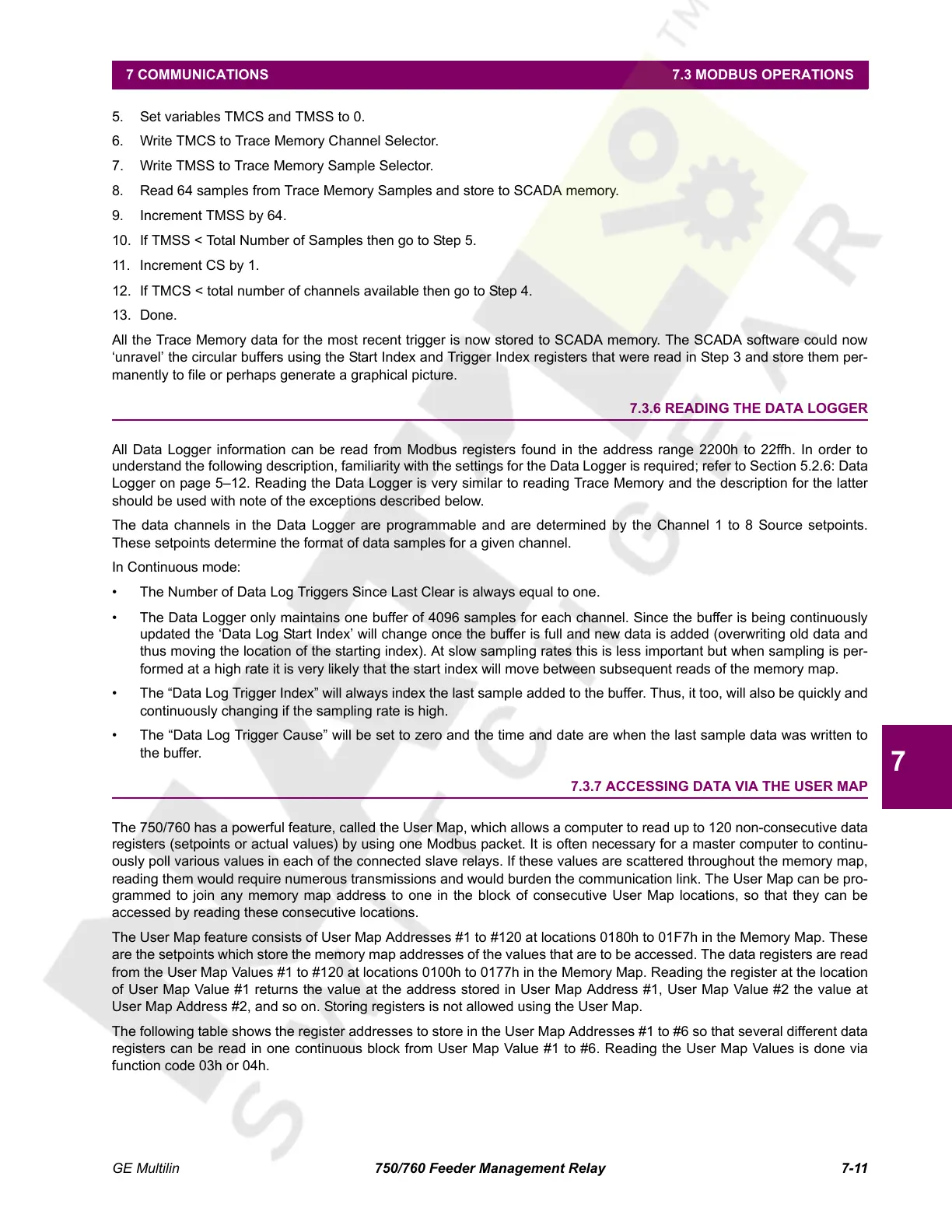GE Multilin 750/760 Feeder Management Relay 7-11
7 COMMUNICATIONS 7.3 MODBUS OPERATIONS
7
5. Set variables TMCS and TMSS to 0.
6. Write TMCS to Trace Memory Channel Selector.
7. Write TMSS to Trace Memory Sample Selector.
8. Read 64 samples from Trace Memory Samples and store to SCADA memory.
9. Increment TMSS by 64.
10. If TMSS < Total Number of Samples then go to Step 5.
11. Increment CS by 1.
12. If TMCS < total number of channels available then go to Step 4.
13. Done.
All the Trace Memory data for the most recent trigger is now stored to SCADA memory. The SCADA software could now
‘unravel’ the circular buffers using the Start Index and Trigger Index registers that were read in Step 3 and store them per-
manently to file or perhaps generate a graphical picture.
7.3.6 READING THE DATA LOGGER
All Data Logger information can be read from Modbus registers found in the address range 2200h to 22ffh. In order to
understand the following description, familiarity with the settings for the Data Logger is required; refer to Section 5.2.6: Data
Logger on page 5–12. Reading the Data Logger is very similar to reading Trace Memory and the description for the latter
should be used with note of the exceptions described below.
The data channels in the Data Logger are programmable and are determined by the Channel 1 to 8 Source setpoints.
These setpoints determine the format of data samples for a given channel.
In Continuous mode:
• The Number of Data Log Triggers Since Last Clear is always equal to one.
• The Data Logger only maintains one buffer of 4096 samples for each channel. Since the buffer is being continuously
updated the ‘Data Log Start Index’ will change once the buffer is full and new data is added (overwriting old data and
thus moving the location of the starting index). At slow sampling rates this is less important but when sampling is per-
formed at a high rate it is very likely that the start index will move between subsequent reads of the memory map.
• The “Data Log Trigger Index” will always index the last sample added to the buffer. Thus, it too, will also be quickly and
continuously changing if the sampling rate is high.
• The “Data Log Trigger Cause” will be set to zero and the time and date are when the last sample data was written to
the buffer.
7.3.7 ACCESSING DATA VIA THE USER MAP
The 750/760 has a powerful feature, called the User Map, which allows a computer to read up to 120 non-consecutive data
registers (setpoints or actual values) by using one Modbus packet. It is often necessary for a master computer to continu-
ously poll various values in each of the connected slave relays. If these values are scattered throughout the memory map,
reading them would require numerous transmissions and would burden the communication link. The User Map can be pro-
grammed to join any memory map address to one in the block of consecutive User Map locations, so that they can be
accessed by reading these consecutive locations.
The User Map feature consists of User Map Addresses #1 to #120 at locations 0180h to 01F7h in the Memory Map. These
are the setpoints which store the memory map addresses of the values that are to be accessed. The data registers are read
from the User Map Values #1 to #120 at locations 0100h to 0177h in the Memory Map. Reading the register at the location
of User Map Value #1 returns the value at the address stored in User Map Address #1, User Map Value #2 the value at
User Map Address #2, and so on. Storing registers is not allowed using the User Map.
The following table shows the register addresses to store in the User Map Addresses #1 to #6 so that several different data
registers can be read in one continuous block from User Map Value #1 to #6. Reading the User Map Values is done via
function code 03h or 04h.
Courtesy of NationalSwitchgear.com

